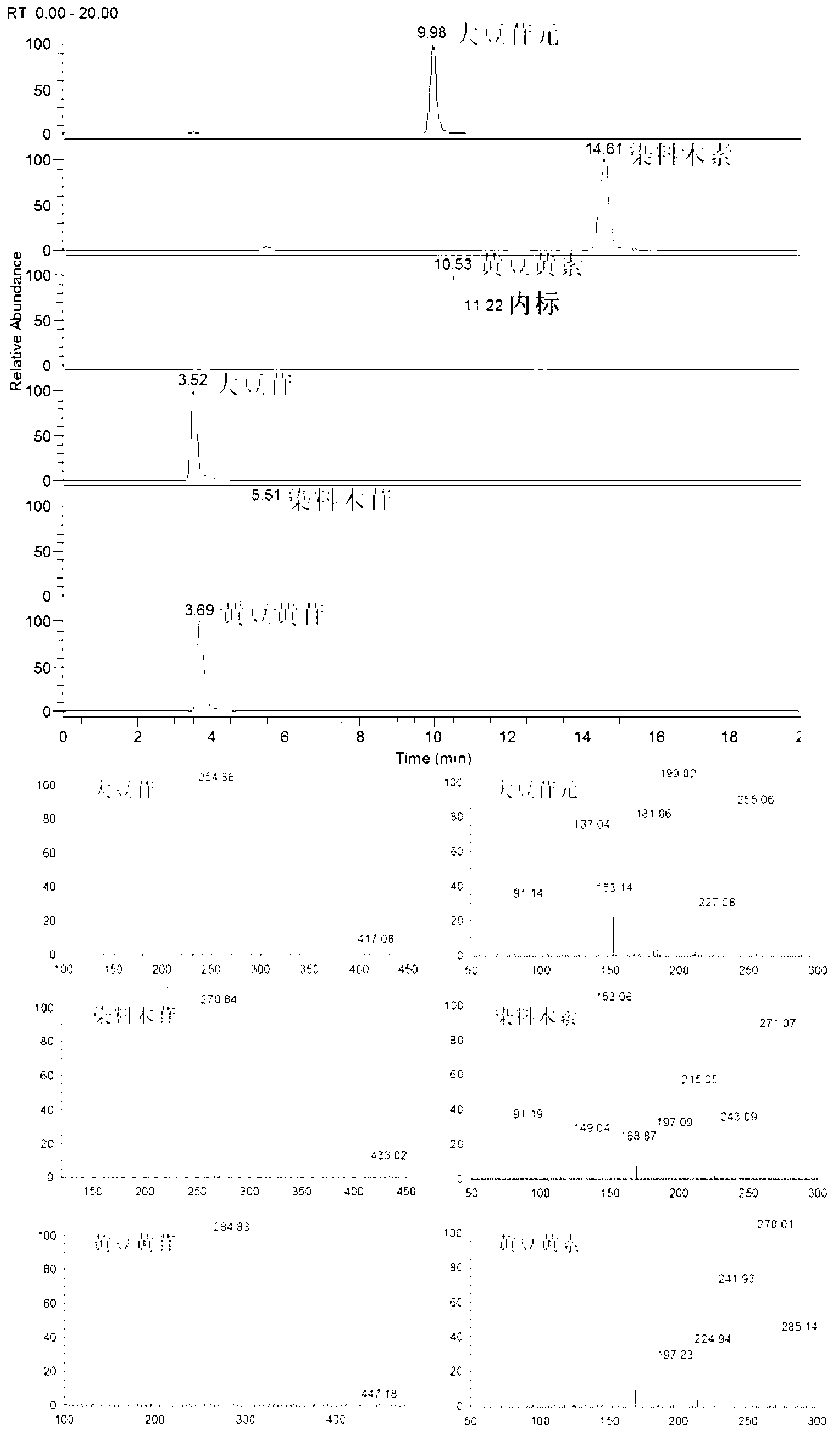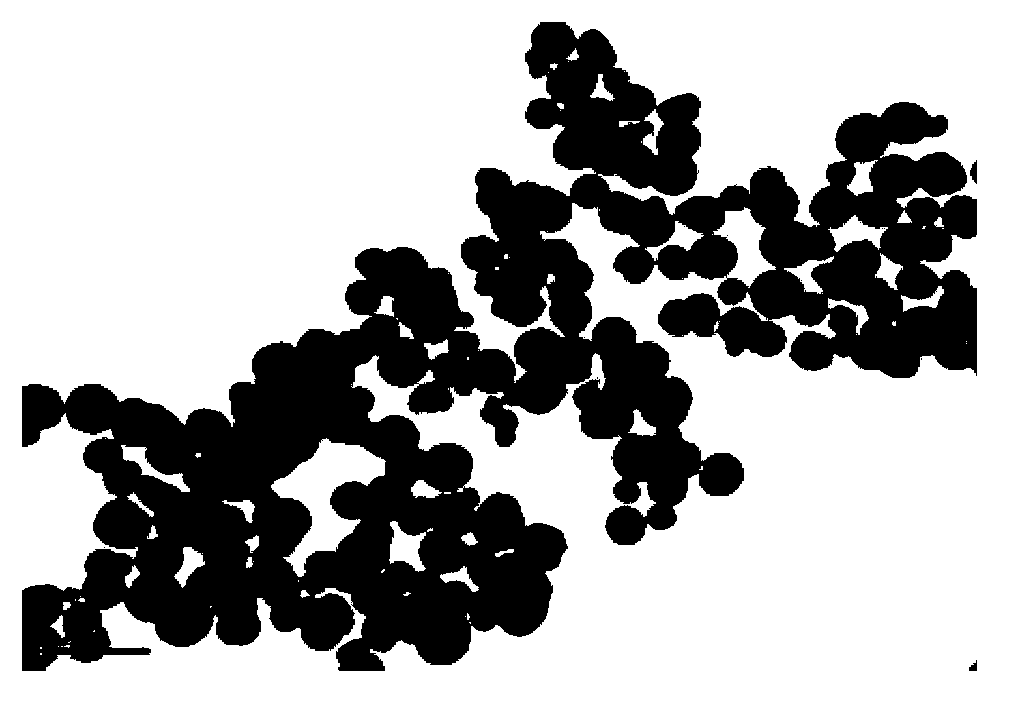Method for analyzing isoflavone in soybeans and products thereof
A technology for soybean isoflavones and soybean isoflavones, which is applied in the field of food chemistry, can solve problems such as inconvenience, and achieve the effects of simple sample preparation method, saving time and energy, and avoiding residues
- Summary
- Abstract
- Description
- Claims
- Application Information
AI Technical Summary
Problems solved by technology
Method used
Image
Examples
Embodiment 1
[0029] Example 1. Preparation of surface-bound baicalin magnetic nanoparticles
[0030] First, amino-terminal magnetic nanoparticles were synthesized: 6.5g of 1,6-hexanediamine, 2g of anhydrous sodium acetate and 1g of FeC 3 ·6H 2 O was dissolved in 30 mL of ethylene glycol and stirred at 50°C until clear; then the solution was transferred to a polytetrafluoroethylene-lined autoclave at 198°C for 6 h. Magnetic nanoparticles were adsorbed and separated, washed with pure water and ethanol three times in sequence, and finally dried under reduced pressure to obtain amino-terminal magnetic nanoparticles.
[0031]Then synthesize surface-bound baicalin magnetic nanoparticles: suspend baicalin and amino-terminal magnetic nanoparticles in 10 mL of 75% DMSO / phosphate buffer (10 mM, pH 5.5) at a mass ratio of 1:3, and then add 35 mg1 -(3-Dimethylaminopropyl)-3-ethylcarbodiimide and sodium salt of N-hydroxysuccinimide sulfonate, shaken for 2h; magnetic nanoparticles obtained by adsorpti...
Embodiment 2
[0032] Example 2. Enrichment and extraction of soy isoflavones in soybeans using surface-bound baicalin magnetic nanoparticles and quantitative analysis
[0033] Grind soybeans, pass through No. 7 standard pharmacopoeia sieve, take 25 mg of powder, add 10% ethanol / water 250 mL, and internal standard calycosin 10 μg, ultrasonically assisted extraction for 10 min; add 100 mg of surface-bound baicalin magnetic nanoparticles to the extract , disperse, mix well, and shake vigorously for 5 minutes; use a magnet to separate the surface-bonded baicalin magnetic nanoparticles adsorbed with soybean isoflavones, and pour and discard the remaining solution; remove the external magnetic field, add 0.1mL methanol, and fully Mix and shake vigorously for 1 min; finally, use a magnet to adsorb the surface-bound baicalin magnetic nanoparticles together, and draw out the eluting solution for use by HPLC-ESI / MS.
[0034] Use SUPELCOSIL TM LC-18 (150mm×2.1mm id5μm) is used as a separation column...
Embodiment 3
[0042] Example 3. Enrichment and extraction of soybean isoflavones in soybean milk using surface-bound baicalin magnetic nanoparticles and quantitative analysis
[0043] Take 0.1 mL of a Chinese brand of soybean milk, add 10 μg of internal standard calycosin, and then add 100 mg of surface-bound baicalin magnetic nanoparticles, disperse, mix thoroughly, and shake vigorously for 5 minutes; use a magnet to separate the surface of the adsorbed soybean isoflavones Bond baicalin magnetic nanoparticles, pour and discard the remaining solution; remove the external magnetic field, add 0.1mL methanol, mix well, and shake vigorously for 1 min; finally, use a magnet to adsorb the surface-bound baicalin magnetic nanoparticles together , draw out the eluent for HPLC-ESI / MS use.
[0044] Use SUPELCOSIL TM LC-18 (150mm×2.1mm id5μm) is used as a separation column, mobile phase conditions: (A) 10% acetonitrile (containing 0.1% formic acid), (B) 90% acetonitrile (containing 0.1% formic acid),...
PUM
| Property | Measurement | Unit |
|---|---|---|
| Granularity | aaaaa | aaaaa |
| Particle size | aaaaa | aaaaa |
Abstract
Description
Claims
Application Information
 Login to View More
Login to View More - R&D
- Intellectual Property
- Life Sciences
- Materials
- Tech Scout
- Unparalleled Data Quality
- Higher Quality Content
- 60% Fewer Hallucinations
Browse by: Latest US Patents, China's latest patents, Technical Efficacy Thesaurus, Application Domain, Technology Topic, Popular Technical Reports.
© 2025 PatSnap. All rights reserved.Legal|Privacy policy|Modern Slavery Act Transparency Statement|Sitemap|About US| Contact US: help@patsnap.com



